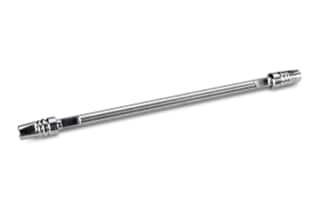
|
Chemistry |
C8 |
|
Separation Mode |
Reversed Phase |
|
Particle Substrate |
Hybrid |
|
pH Range Min |
1 pH |
|
pH Range Max |
12 pH |
|
Maximum Pressure |
18000 psi (1240 Bar) |
|
Endcapped |
Yes |
|
Silanol Activity |
Low |
|
Particle Shape |
Spherical |
|
Particle Size |
2.5 µm |
|
Endfitting Type |
Parker-style |
|
Pore Size |
130 Å |
|
Format |
Column |
|
Surface Area |
185 |
|
System |
UPLC, UHPLC |
|
Particle Technology |
BEH |
|
USP Classification |
L7 |
|
Inner Diameter |
2.1 mm |
|
Length |
150 mm |
|
Carbon Load |
13 % |
|
eCord |
Yes |
|
UNSPSC |
41115709 |
|
Brand |
XBridge |
|
Product Type |
Columns |
|
Units per Package |
1 pk |

XBridge BEH C8 Column, 130Å, 2.5 µm, 2.1 mm X 150 mm, 1/pk
The XBridge BEH HPLC Columns are intended to maximize productivity. Whether you are developing a quality-control method or a cutting-edge LC-MS assay, there is an XBridge Column that will meet your separation requirements. The XBridge Peptide BEH C8 Columns are extremely dependable, producing high-quality, consistent results. You can use your equipment with confidence, knowing that the results are reliable because these Columns are produced in specialized Waters' manufacturing plants and facilities that follow the strictest cGMP and ISO 9001 standards. The packing materials for the XBridge Peptide BEH C8 Columns have been designed to provide excellent peak shape, high efficiency, and outstanding stability.
When compared to the XBridge BEH C18 sorbent, the XBridge BEH C8 sorbent is less retentive. Anyone developing methods may prefer the faster speed provided by a less retentive column while improving peak shape and chromatographic performance. The tri-functionally bonded sorbent has the broadest usable pH range (1-12), superior low pH stability, and extremely low column bleed. 2.5 µm eXtended Performance [XP] columns with ultra-low dispersion hardware provide exceptional separation performance, robustness, and throughput for HPLC assays while enabling a seamless transition path toward UPLC.
The unique properties of the XBridge Peptide BEH C8 Column allow for batch-to-batch consistency in synthetic peptide and protein digest separations. Count on the versatility of an XBridge BEH HPLC Column for robust HPLC methods, seamless UPLC transferability, or preparative scaling for product isolation. You can shop for lab equipment on our website and contact a member of our global support team with any questions you may have or if you need guidance on the best product selection for your lab equipment.
You may also be interested in reviewing Neutrals QC Reference Material; this material can be used in any chromatographic system that has a UV detector. It is intended to serve as a system benchmarking standard. The mixture contains only neutral chemicals. When used consistently and with control charts, the QC Reference Material will give you confidence in your results, reduce troubleshooting and rerun time, and allow you to compare results from different laboratories. With this reference material, a variety of separation techniques can be used.
What Is the Mass Spectrometry Principle in Chromatography?
Mass spectrometry (MS) fundamental premise is to produce ions from inorganic or organic materials using any suitable technique, separate them based on their mass-to-charge ratio (m/z), and then detect them qualitatively and quantitatively based on their m/z and abundance.